Sustainable Synthesis of Epoxidized Cynara C. Seed Oil
Abstract
1. Introduction
2. Results and Discussion
3. Materials and Methods
3.1. Materials
3.2. Experimental Runs
3.2.1. Hydrogen Peroxide Decomposition Runs
3.2.2. Cardoon Seed Oil Epoxidation Runs
4. Conclusions
Author Contributions
Funding
Acknowledgments
Conflicts of Interest
References
- Chen, T.-L.; Kim, H.; Pan, S.-Y.; Tseng, P.-C.; Lin, Y.-P.; Chiang, P.-C. Implementation of green chemistry principles in circular economy system towards sustainable development goals: Challenges and perspectives. Sci. Total Environ. 2020, 716, 136998. [Google Scholar] [CrossRef] [PubMed]
- Hassan, S.; Williams, G.A.; Jaiswal, A.K. Moving towards the second generation of lignocellulosic biorefineries in the EU: Drivers, challenges, and opportunities. Renew. Sustain. Energy Rev. 2019, 101, 590–599. [Google Scholar] [CrossRef]
- Bakshi, B.R. Toward sustainable chemical engineering: The role of process systems engineering. Annu. Rev. Chem. Biomol. Eng. 2019, 10, 265–288. [Google Scholar] [CrossRef] [PubMed]
- Halpaap, A.; Dittkrist, J. Sustainable chemistry in the global chemicals and waste management agenda. Curr. Opin. Green Sustain. Chem. 2018, 9, 25–29. [Google Scholar] [CrossRef]
- European Commission. Towards a Circular Economy: A Zero Waste Programme for Europe. Available online: http://ec.europa.eu/environment/circular-economy/index_en.htm (accessed on 24 March 2019).
- Biermann, U.; Bornscheuer, U.T.; Meier, M.A.R.; Metzger, J.O.; Schäfer, H.J. Oils and fats as renewable raw materials in chemistry. Angew. Chem. Int. Ed. 2011, 50, 3854–3871. [Google Scholar] [CrossRef]
- Petrović, Z.S. Polyurethanes from vegetable oils. Polym. Rev. 2008, 48, 109–155. [Google Scholar] [CrossRef]
- Benessere, V.; Cucciolito, M.E.; De Santis, A.; Di Serio, M.; Esposito, R.; Ruffo, F.; Turco, R. Sustainable process for production of azelaic acid through oxidative cleavage of oleic acid. J. Am. Oil Chem. Soc. 2015, 92, 1701–1707. [Google Scholar] [CrossRef]
- Huang, X.; Yang, X.; Liu, H.; Shang, S.; Cai, Z.; Wu, K. Bio-based thermosetting epoxy foams from epoxidized soybean oil and rosin with enhanced properties. Ind. Crops Prod. 2019, 133, 111540. [Google Scholar] [CrossRef]
- Karmakar, G.; Ghosh, P.; Sharma, B.K. Chemically modifying vegetable oils to prepare green lubricants. Lubricants 2017, 5, 44. [Google Scholar] [CrossRef]
- Lligadas, G.; Ronda, J.C.; Galia, M.; Cadiz, V. Renewable polymeric materials from vegetable oils: A perspective. Mater. Today 2013, 16, 337–343. [Google Scholar] [CrossRef]
- Turco, R.; Pischetola, C.; Di Serio, M.; Vitiello, R.; Tesser, R.; Santacesaria, E. Selective epoxidation of soybean oil in the presence of h–y zeolite. Ind. Eng. Chem. Res. 2017, 56, 7930–7936. [Google Scholar] [CrossRef]
- Hosney, H.; Nadiem, B.; Ashour, I.; Mustafa, I.; El-Shibiny, A. Epoxidized vegetable oil and bio-based materials as PVC plasticizer. J. Appl. Polym. Sci. 2018, 135, 46270. [Google Scholar] [CrossRef]
- Pérez-Sena, W.Y.; Salmi, T.; Estel, L.; Leveneur, S. Thermal risk assessment for the epoxidation of linseed oil by classical Prisleschajew epoxidation and by direct epoxidation by H2O2 on alumina. J. Therm. Anal. Calorim. 2019, 140, 673–684. [Google Scholar] [CrossRef]
- Lyche, J.L. Phthalates. In Reproductive and Developmental Toxicology, 2nd ed.; Gupta, R.C., Ed.; Academic Press: Cambridge, MA, USA, 2017; pp. 829–856. [Google Scholar]
- Grand Review Research, Bio-Platicizers Market and Segment Forecast to 2025. Available online: https://www.grandviewresearch.com/press-release/global-bio-plasticizers-market (accessed on 1 May 2019).
- Turco, R.; Tesser, R.; Russo, V.; Vitiello, R.; Fagnano, M.; Di Serio, M. Comparison of different possible technologies for epoxidation of Cynara cardunculus seed oil. Eur. J. Lipid Sci. Technol. 2019, 122. [Google Scholar] [CrossRef]
- Demirbas, A. Potential resources of non-edible oils for biodiesel. Energy Sources Part B Econ. Plan. Policy 2009, 4, 310–314. [Google Scholar] [CrossRef]
- Gominho, J.; Curt, M.D.; Lourenço, A.; Fernández, J.; Pereira, H. Cynara cardunculus L. as a biomass and multi-purpose crop: A review of 30 years of research. Biomass Bioenergy 2018, 109, 257–275. [Google Scholar] [CrossRef]
- Torres, C.M.; Rios, S.D.; Torras, C.; Salvadó, J.; Mateo-Sanz, J.M.; Jiménez, L. Sustainability analysis of biodiesel production from Cynara Cardunculus crop. Fuel 2013, 111, 535–542. [Google Scholar] [CrossRef]
- Toscano, V.; Sollima, L.; Genovese, C.; Melilli, M.; Raccuia, S.A. Pilot plant system for biodiesel and pellet production from cardoon: Technical and economic feasibility. Acta Hortic. 2016, 429–442. [Google Scholar] [CrossRef]
- Raccuia, S.A.; Melilli, M.G. Cynara cardunculus L., a potential source of inulin in the Mediterranean environment: Screening of genetic variability. Aust. J. Agric. Res. 2004, 55, 693–698. [Google Scholar] [CrossRef]
- Goud, V.V.; Patwardhan, A.V.; Dinda, S.; Pradhan, N.C. Kinetics of epoxidation of jatropha oil with peroxyacetic and peroxyformic acid catalysed by acidic ion exchange resin. Chem. Eng. Sci. 2007, 62, 4065–4076. [Google Scholar] [CrossRef]
- Di Serio, M.; Russo, V.; Santacesaria, E.; Tesser, R.; Turco, R.; Vitiello, R. Liquid–liquid–solid model for the epoxidation of soybean oil catalyzed by amberlyst-16. Ind. Eng. Chem. Res. 2017, 56, 12963–12971. [Google Scholar] [CrossRef]
- Aguilera, A.F.; Tolvanen, P.; Oger, A.; Eränen, K.; Leveneur, S.; Mikkola, J.; Salmi, T. Screening of ion exchange resin catalysts for epoxidation of oleic acid under the influence of conventional and microwave heating. J. Chem. Technol. Biotechnol. 2019, 94, 3020–3031. [Google Scholar] [CrossRef]
- Guidotti, M.; Gavrilova, E.; Galarneau, A.; Coq, B.; Psaro, R.; Ravasio, N. Epoxidation of methyl oleate with hydrogen peroxide. The use of Ti-containing silica solids as efficient heterogeneous catalysts. Green Chem. 2011, 13, 1806–1811. [Google Scholar] [CrossRef]
- Turco, R.; Aronne, A.; Carniti, P.; Gervasini, A.; Minieri, L.; Pernice, P.; Tesser, R.; Vitiello, R.; Di Serio, M. Influence of preparation methods and structure of niobium oxide-based catalysts in the epoxidation reaction. Catal. Today 2015, 254, 99–103. [Google Scholar] [CrossRef]
- Turco, R.; Vitiello, R.; Vergara, A.; Di Serio, M.; Tesser, R.; Andini, S. Niobium Based Catalysts for Methyl Oleate Epoxidation Reaction. Top. Catal. 2017, 36, 1054–1061. [Google Scholar] [CrossRef][Green Version]
- Scotti, N.; Ravasio, N.; Evangelistib, C.; Psaro, R.; Penso, M.; Niphadkar, P.S.; Bokade, V.V.; Guidotti, M. Epoxidation of Karanja (Millettia pinnata) oil methyl esters in the presence of hydrogen peroxide over a simple niobium-containing catalyst. Catalysts 2019, 9, 344. [Google Scholar] [CrossRef]
- Turco, R.; Pischetola, C.; Di Serio, M.; Tesser, R.; Andini, S. New findings on soybean and methylester epoxidation with alumina as the catalyst. RSC Adv. 2016, 6, 31647–31652. [Google Scholar] [CrossRef]
- Sepulveda, J.; Teixeira, S.; Schuchardt, U. Alumina-catalyzed epoxidation of unsaturated fatty esters with hydrogen peroxide. Appl. Catal. A Gen. 2007, 318, 213–217. [Google Scholar] [CrossRef]
- Rinaldi, R.; Fujiwara, F.Y.; Holderich, W.; Schuchardt, U. Tuning the acidic properties of aluminas via sol-gel synthesis: New findings on the active site of alumina-catalyzed epoxidation with hydrogen peroxide. J. Catal. 2006, 244, 92–101. [Google Scholar] [CrossRef]
- Suarez, P.A.Z.; Pereira, M.S.C.; Doll, K.M.; Sharma, B.K.; Erhan, S.Z. Epoxidation of methyl oleate using heterogeneous catalyst. Ind. Eng. Chem. Res. 2009, 48, 3268–3270. [Google Scholar] [CrossRef]
- Byrne, F.; Jin, S.; Paggiola, G.; Petchey, T.H.M.; Clark, J.H.; Farmer, T.J.; Hunt, A.J.; McElroy, C.R.; Sherwood, J. Tools and techniques for solvent selection: Green solvent selection guides. Sustain. Chem. Process. 2016, 4. [Google Scholar] [CrossRef]
- Henderson, R.K.; Jiménez-González, C.; Constable, D.J.C.; Alston, S.R.; Inglis, G.G.A.; Fisher, G.; Sherwood, J.; Binks, S.P.; Curzons, A.D. Expanding GSK’s solvent selection guide—Embedding sustainability into solvent selection starting at medicinal chemistry. Green Chem. 2011, 13, 854–862. [Google Scholar] [CrossRef]
- Prat, D.; Pardigon, O.; Flemming, H.-W.; Letestu, S.; Ducandas, V.; Isnard, P.; Guntrum, E.; Senac, T.; Ruisseau, S.; Cruciani, P.; et al. Sanofi’s solvent selection guide: A step toward more sustainable processes. Org. Process Res. Dev. 2013, 17, 1517–1525. [Google Scholar] [CrossRef]
- Lomba, L.; Giner, B.; Bandrés, I.; Lafuente, C.; Pino-Otín, M.R. Physicochemical properties of green solvents derived from biomass. Green Chem. 2011, 13, 2062. [Google Scholar] [CrossRef]
- Available online: https://people.chem.umass.edu/xray/solvent.html (accessed on 6 June 2020).
- Russo, V.; Protasova, L.; Turco, R.; De Croon, M.H.J.M.; Hessel, V.; Santacesaria, E. Hydrogen peroxide decomposition on manganese oxide supported catalyst: From batch reactor to continuous microreactor. Ind. Eng. Chem. Res. 2013, 52, 7668–7676. [Google Scholar] [CrossRef]
- Van Vliet, M.C.A.; Mandelli, D.; Arends, I.W.C.E.; Schuchardt, U.; Sheldon, R.A. Alumina: A cheap, active and selective catalyst for epoxidations with (aqueous) hydrogen peroxide. Green Chem. 2001, 3, 243–246. [Google Scholar] [CrossRef]
- Corma, A.; Esteve, P.; Martínez, A. Solvent effects during the oxidation of olefins and alcohols with hydrogen peroxide on Ti-Beta catalyst: The influence of the hydrophilicity–hydrophobicity of the zeolite. J. Catal. 1996, 161, 11–19. [Google Scholar] [CrossRef]
- Knozinger, H. Advances in Catalysis; Accademic Press: New York, NY, USA, 1976; p. 25. [Google Scholar]
- Kolthoff, I.M.; Sandell, E.B.; Meehan, E.J. Treatise on Analytical Chemistry; John Wiley & Sons: New York, NY, USA, 1993; Volume 2, p. 888. [Google Scholar]
- International Organization for Standardization. Animal and Vegetable Fats and Oils—Determination of Iodine Value; ISO: Geneva, Switzerland, 2018; ISO 3961:2018. [Google Scholar]
- International Organization for Standardization. Animal and Vegetable Fats and Oils—Gas Chromatography of Fatty Acid Methyl Esters; ISO: Geneva, Switzerland, 2017; ISO 12966-4:2005/ISO 12966-2:2017. [Google Scholar]
- ASTM International. Standard Test Methods for Epoxy Content of Epoxy Resins; ASTM: West Conshohocken, PA, USA, 1997; ASTM D1652-97. [Google Scholar]

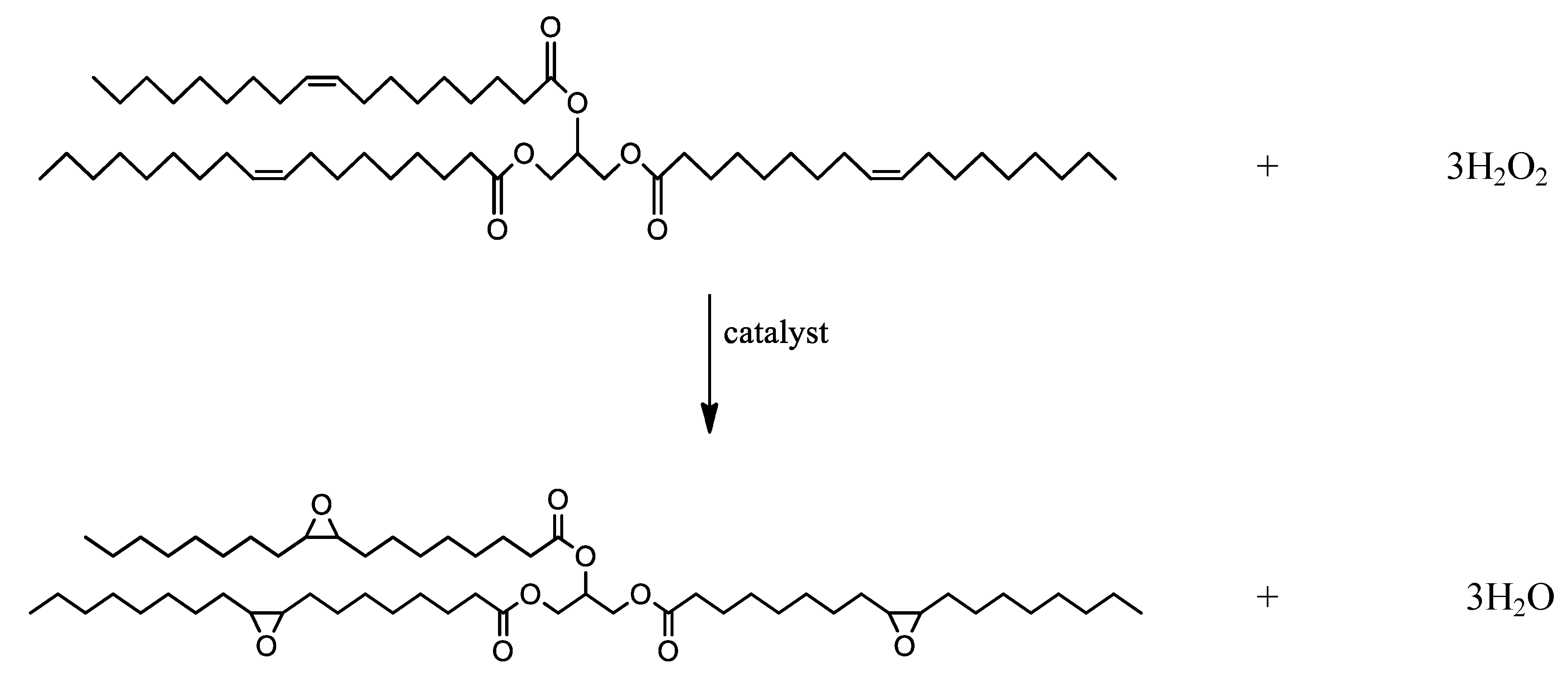
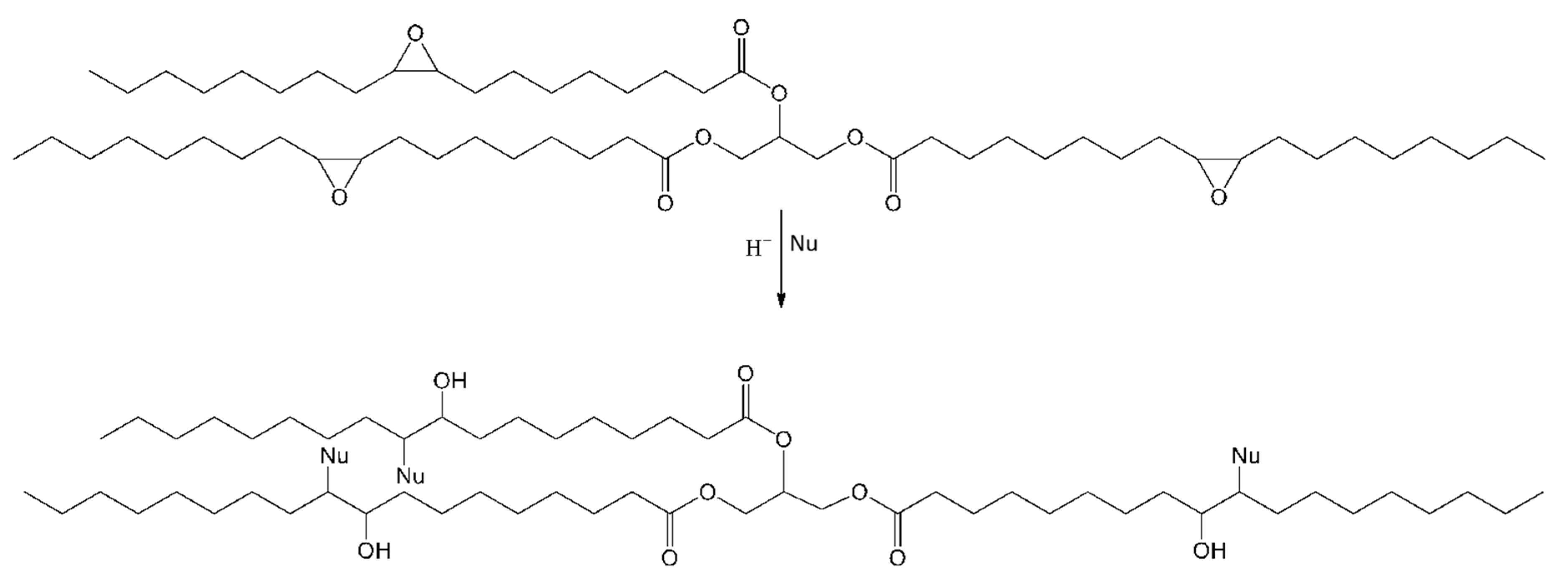
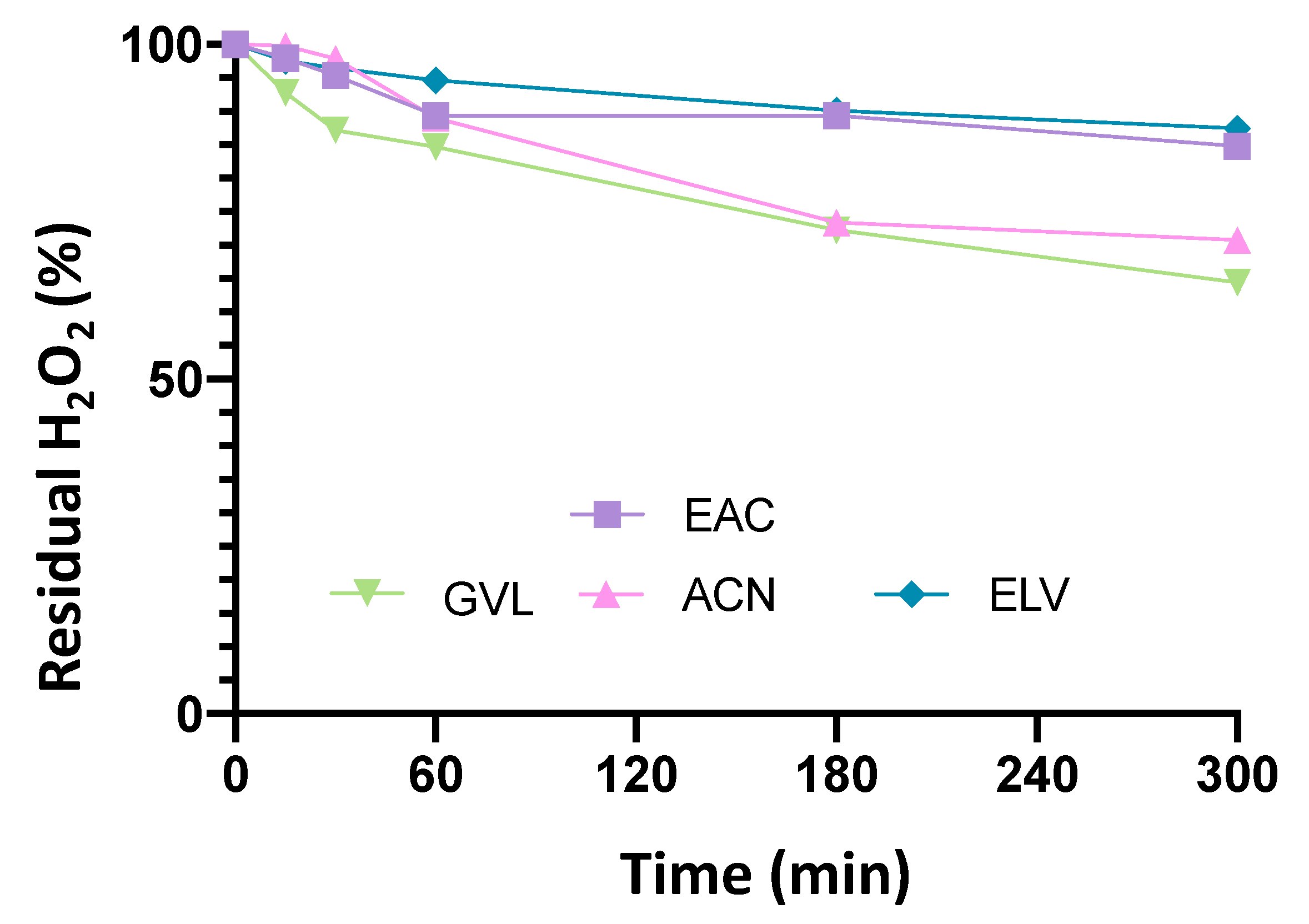
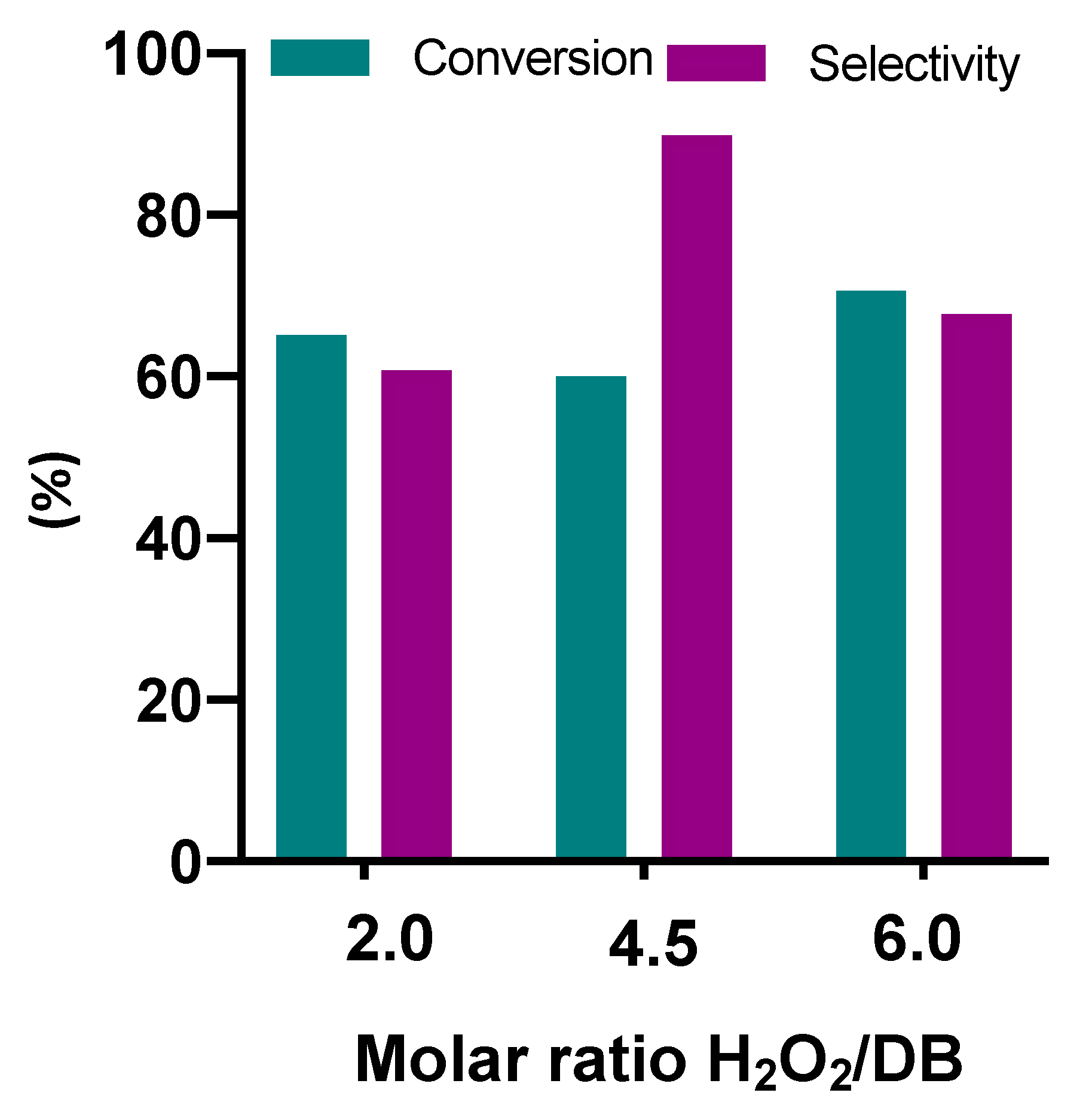
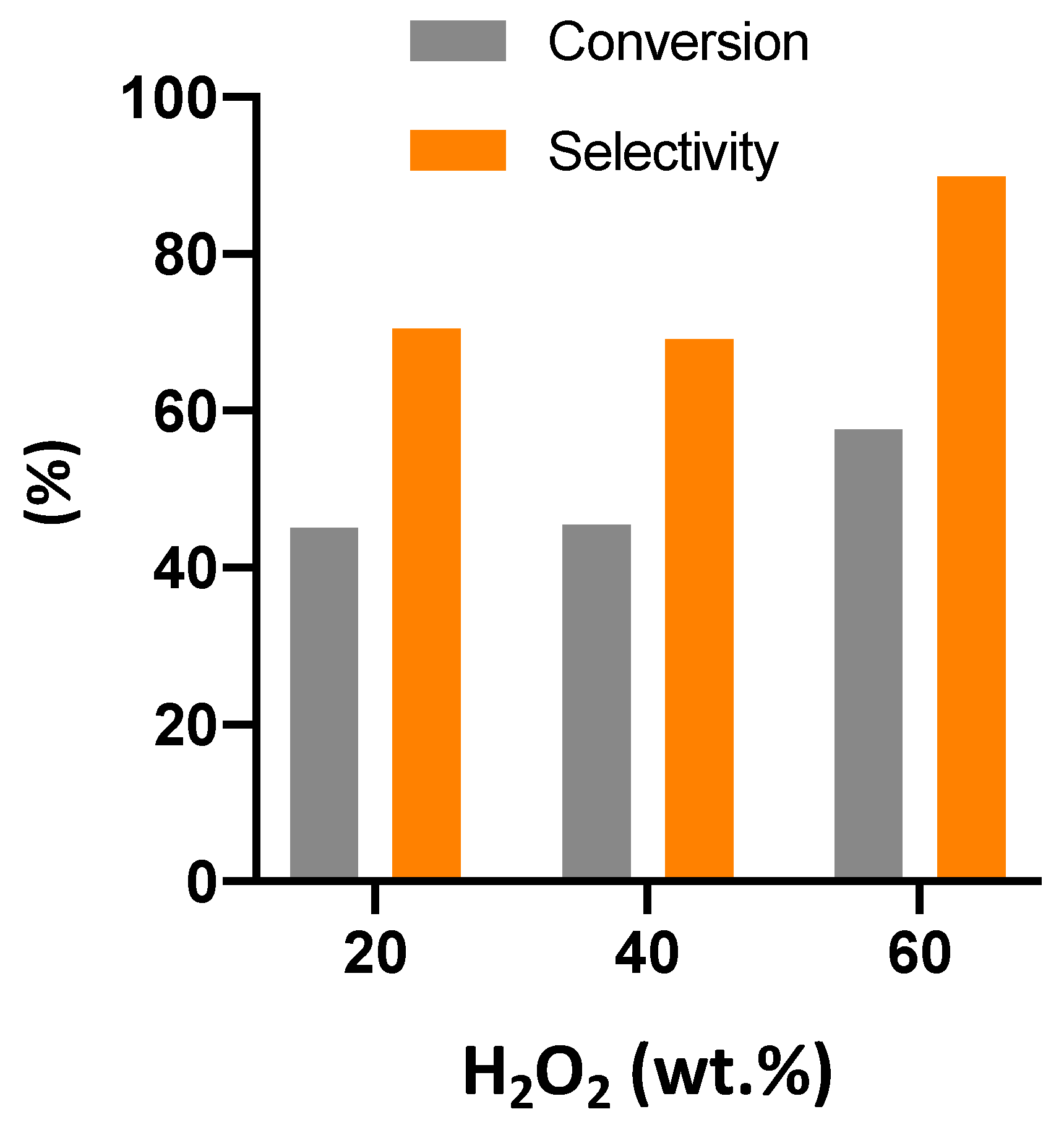
| Solvent | Acr. | Formula | MW (g mol−1) | BP(a) (K) | ρ(b) (kg m−3) | ε(c) | μ(d) (D) | Miscibility with water (e) (g L−1) |
|---|---|---|---|---|---|---|---|---|
| Acetonitrile | ACN | C2H3N | 41.05 | 355 | 780 | 37.50 | 3.44 | miscible |
| Ethyl acetate | EAC | C4H8O2 | 88.11 | 350 | 901 | 6.02 | 1.78 | 85.3 |
| γ-valerolactone | GVL | C5H8O2 | 100.12 | 480 | 1103 | 36.47 | 4.71 | >100 |
| Ethyl levulinate | ELV | C7H12O3 | 144.17 | 479 | 1010 | 11.90 | 5.19 | 22.7 |
| RUN | Solvent | H2O2 (60 wt. %) (g) | H2O (g) | H2O2/DB |
|---|---|---|---|---|
| 1 | - | 6.90 | - | 4.5 |
| 2 | ACN | 6.90 | - | 4.5 |
| 3 | EAC | 6.90 | - | 4.5 |
| 4 | GVL | 6.90 | - | 4.5 |
| 5 | ELV | 6.90 | - | 4.5 |
| 6 | GVL | 3.03 | - | 2.0 |
| 7 | GVL | 9.08 | - | 6.0 |
| 8 | GVL | 6.90 | 3.50 | 4.5 |
| 9 | GVL | 6.90 | 13.60 | 4.5 |
© 2020 by the authors. Licensee MDPI, Basel, Switzerland. This article is an open access article distributed under the terms and conditions of the Creative Commons Attribution (CC BY) license (http://creativecommons.org/licenses/by/4.0/).
Share and Cite
Turco, R.; Di Serio, M. Sustainable Synthesis of Epoxidized Cynara C. Seed Oil. Catalysts 2020, 10, 721. https://doi.org/10.3390/catal10070721
Turco R, Di Serio M. Sustainable Synthesis of Epoxidized Cynara C. Seed Oil. Catalysts. 2020; 10(7):721. https://doi.org/10.3390/catal10070721
Chicago/Turabian StyleTurco, Rosa, and Martino Di Serio. 2020. "Sustainable Synthesis of Epoxidized Cynara C. Seed Oil" Catalysts 10, no. 7: 721. https://doi.org/10.3390/catal10070721
APA StyleTurco, R., & Di Serio, M. (2020). Sustainable Synthesis of Epoxidized Cynara C. Seed Oil. Catalysts, 10(7), 721. https://doi.org/10.3390/catal10070721






